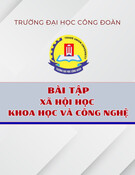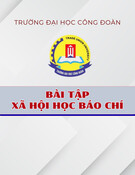
Facebook Discourse Analysis of US President Donald Trump
Assist. Prof. PhD. Tănase Tasențe
“Ovidius” University of Constanța, Romania
office@pluscommunication.eu
Abstract. SNSs, such as Facebook, focus all their attention more on politician communication
than institutional communication (political party, government, parliament, presidency, etc.),
which encourages the implementation of communication strategies for personalized campaigns.
Thus, most of the times, one can reach the paradox that the image of the politicians is more
visible than the image of the party, and the personalized aspects of the strategy of the political
actor can even contradict the strategies of the communication structures of the political parties.
Personalized communication in social media is also highlighted by the use of tagging, most
political leaders using this tool to create image links with other political personalities or civil
society (ministers, political groups of the same political party, political activists or even political
opponents), seeking so that the original post is reproduced and disseminated by those mentioned,
in their social groups, forming conversation communities with users that confirm existing
convictions. This study focused on analyzing the Key Performance Indicators (KPIs) that
facilitate Social Media Communication of Donald Trump, the President of United States of
America (number of fans, types of posts, interactions etc.) and analyzing Donald Trump's
Facebook speech and identify the most commonly used expressions in Social Media during the
term of President. The monitoring period is 20.01.2017 - 16.08.2019.
Keywords. Donald Trump, US President, Social Media Communication, Web 2.0, online
reactions, Facebook
1 Introduction
With the incorporation of SNSs into the strategies of political communication, the top-
down model of unidirectional message reproduction and without the possibility of interaction
between the protagonists and the recipients of the published contents entered into discussion. If
in this traditional scheme, only politicians and political parties were able to put their voice in
the public sphere, using traditional means of communication, the broad universe of social
networks came to offer tools to change this paradigm from a communication
Thus, online social networks, such as Facebook, focus all their attention more on
politician communication than institutional communication (political party, government,
parliament, presidency, etc.), which encourages the implementation of communication
strategies for personalized campaigns. Thus, most of the times, one can reach the paradox that
the image of the politicians is more visible than the image of the party, and the personalized
aspects of the strategy of the political actor can even contradict the strategies of the
communication structures of the political parties.
Although it is assumed that SNSs will differentiate at the mechanism level from the
classical communication channels, offering a much greater openness for debate, recent studies
indicate that political leaders not only do not encourage conversation with their followers
26
Technium Social Sciences Journal
Vol. 5, 26-31, March 2020
ISSN: 2668-7798
www.techniumscience.com

(Amado, Tarullo, 2016; Graham et al., 2014; Waisbord, 2015) but also that the communication
they star in social networks does not promote the inclusion of new voices in discussions on
public affairs (Calvo, Aruguete, 2018).
Moreover, according to a study by Raquel Tarullo (2018), it shows "a contradictory
use of social networks that, although it allows political leaders to include in the communication
to the addressee from the use of tags, links to other pages, hashtags and sharing publications
originating from the walls of Other users' accounts to promote interaction, the nature of
hashtags, tags and links to other pages approximates a reproduction of the communicative
behavior that leaders star in traditional media". At the same time, it is shown that without a
search for conversation or interaction based on the limited inclusion of the engagement features
offered by Facebook, leaders replicate a model of personalist political communication,
centralized in the leader's own figure.
Personalized communication in social media is also highlighted by the use of tagging,
most political leaders using this tool to create image links with other political personalities or
civil society (ministers, political groups of the same political party, political activists or even
political opponents), seeking so that the original post is reproduced and disseminated by those
mentioned, in their social groups, forming conversation communities with users that confirm
existing convictions.
The same hypothesis was also demonstrated by Maria Pilgun and Galina
Gradoselskaya (2015), who showed after a large study conducted in Russia that: (1) Politically
active actors in Facebook are distributed in several clusters according to the political
affiliations; (2) Communicative interaction between different clusters has the nature of conflict
and (3) Proficiency level of sociolinguistic resources does not depend on belonging to certain
cluster.
2 Analysis of Donald Trump's Facebook speech (January 20, 2017 - August 16,
2019)
2.1. Research objectives
O1: Analyzing the Key Performance Indicators (KPIs) that facilitate Social Media
Communication of Donald Trump, the President of United States of America (number of fans,
types of posts, interactions etc.)
O2: Analyzing Donald Trump's Facebook speech and identify the most commonly
used expressions in Social Media during the term of President
2.2. Methodology
To achieve the research objectives, we will use both quantitative and qualitative
methods. Thus, we will analyze the key performance indicators (KPIs) that facilitate Donald
Trump’s online communication, namely: the number of fans, the number of daily posts, the
engagement rate, the dominant reactions, etc. At the same time, using the text analysis platform
- https://www.online-utility.org/text/analyzer.jsp - we will centralize and analyze the most
commonly used words and expressions on Donald Trump's Facebook, in order to determines
the communication directions used during the term of president. The monitoring period is
20.01.2017 - 16.08.2019.
27
Technium Social Sciences Journal
Vol. 5, 26-31, March 2020
ISSN: 2668-7798
www.techniumscience.com

2.3. Centralization and data analysis
Evolution of the number of the fans and the reactions of the fans
With the takeover of the President of the United States of America, on January 20,
2017, Donald J. Trump experienced an exponential increase in the number of fans on Facebook
- from 18 million fans on January 20, 2017 to 21. millions of fans on February 22, 2017. Since
then, the evolution of the number of fans has been constant, on August 16, 2019, Donald
Trump's Facebook page has registered almost 24.3 million fans. Thus, we can see that in the
first month of office (January 20, 2017 - February 22, 2017), Donald Trump increased by 3
million fans, and during February 23, 2017 - August 16, 2019 (2 years and 6 months), an
increase of 3.3 million fans.
During the monitored period (January 20, 2017 - August 16, 2019), Donald Trump
posted on his Facebook page 5,007 posts, of which: 36.9% video, 30.5% photos, 18.5% status,
14% links. The advertising activity was intense, the rate being 10 posts per day, and the
relatively high engagement rate, 2.7%.
Type
Total
Avg.
Reactions
Avg.
Comments
Avg. Shares
ø Total
interactions /
Post
Status
927
54,349
6,370
4,429
74,447
Pictures
1,529
57,542
5,782
6,806
80,033
Links
703
34,856
3,829
4,713
49,899
Videos
1,848
41,621
6,810
7,220
64,386
Total
5,007
47,890
5,996
6,225
68,993
Text analyzer – most frequent phrases used by Donald Trump
For analysis, we will only consider expressions that contain at most 4 words, to
determine the key messages most commonly used in Donald Trump's Facebook speech. During
the mentioned period, in the 5,007 posts, Donald Trump uses 147,664 words, which means, on
average, 29.5 words per post and a number of 11,802 sentences, which represents an average
of 2.36 sentences per post (relatively long posts).
28
Technium Social Sciences Journal
Vol. 5, 26-31, March 2020
ISSN: 2668-7798
www.techniumscience.com

The Democrats, Donald Trump's opposition party, appear in the president's speech, on
the Facebook page, 429 times (in 413 posts) out of a total of 5,007 posts (8.57%), and his party,
Republicans, 109 times out of a total of 5,007 posts (2.18%). Moreover, most often we can see
the term Democrats mentioned in the following expressions: "the radical democrats" (22 times),
"the democrats wasted 2 years and $25 million" (3 times), "could not be more clear democrats
produce mobs" (3 times) or "the democrats raised millions off a lie" (3 times). On the other
hand, Donald Trump most often mentions the term Republicans in the following terms: "with
republican members of the senate" (10 times) and "a vote for republicans is a vote" (4 times).
Words
Likes
Comments
Shares
Love
Haha
Wow
Sorry
Anger
Democrats
35247
5647
6463
3813
1211
249
328
1490
Republicans
38789
6312
5018
4459
1049
169
267
827
Republicans &
Democrats
39762
6310
5719
4595
932
189
228
995
When he used the term "Democrats" in his posts, we can see an average interaction
rate of 0.23% and an average of the reactions, as follows: 35,247 likes per post, 5,647 comments
per post, 6,463 shares per post, 3,813 love, 1,211 haha, 249 wow, 328 sorry and 1,490 anger .
On the other hand, the term "Republicans" generated an average interaction rate of
0.25% and an average of reactions, as follows: 38,789 likes per post, 6,312 comments, 5,018
shares, 4,459 love reactions, 1,049 haha, 169 wow, 267 sorry and 827 anger.
Both parties - "Democrats" and "Republicans" - are used in the same posting, in 41 of
the cases, generating an interaction rate of 0.26%. At the same time, the average fan reaction
per post is as follows: 39,762 likes, 6,310 comments, 5,719 shares, 4,595 love, 932 haha, 189
wow, 228 sorry and 995 anger.
From the chart above, we can see that when he used the term "democrats", there was
a negative reaction among the fans (anger, sorry and haha), and when he used the term
"republicans", love reactions are more common. On the other hand, stronger interaction is
29
Technium Social Sciences Journal
Vol. 5, 26-31, March 2020
ISSN: 2668-7798
www.techniumscience.com

when, in the same posts, both terms - "Republicans" and "Democrats" are used. In this case, we
can see an increase in the rate of likes and loves.
No.
Top phrases containing 4 words (without punctuation marks)
Occurrences
1.
make america great again
133
2.
of the united states
67
3.
at the white house
64
4.
vice president mike pence
60
5.
trump's schedule for wednesday
60
6.
trump's schedule for tuesday
56
7.
the fake news media
56
8.
first lady melania trump
54
9.
join me live in
54
10.
· travel to washington
52
11.
trump's schedule for thursday
52
12.
for a #maga rally
50
13.
travel to washington d
50
14.
meeting with secretary of
50
15.
trump's tentative schedule for
49
16.
crowd for a #maga
49
17.
great crowd for a
49
18.
with the secretary of
48
19.
with vice president mike
48
20.
trump's schedule for friday
46
21.
bilateral meeting with the
45
22.
to the white house
42
23.
america great again rally
42
24.
in the history of
42
25.
for the american people
41
26.
trump's schedule for monday
41
27.
with secretary of state
41
28.
with the president of
40
29.
the prime minister of
39
30.
· meeting with secretary
39
31.
expanded bilateral meeting with
39
32.
receives daily intelligence briefing
39
33.
meeting with prime minister
38
34.
lunch with vice president
36
Viewed from the perspective of the topics most commonly used in the Social Media
discourse, we can see that the slogan in the electoral campaign - "Make America great again"
was retained during the term of office, being used in 133 posts, and the abbreviation of the
slogan - "MAGA rally" - in 50 posts. On the other hand, we can see that the communicators are
posting the President's program for each day, and most often we can see posts in which the
program is mentioned on Wednesday (60 mentions), on Tuesday (56 mentions), on Thursday (
52 mentions) and Friday (46 mentions). At the same time, US Vice President Mike Pence is
mentioned by Donald Trump in 60 posts and First Lady Melania Trump in 54 posts. The topic
30
Technium Social Sciences Journal
Vol. 5, 26-31, March 2020
ISSN: 2668-7798
www.techniumscience.com




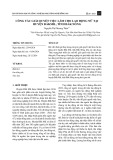
![Tài liệu tập huấn, bồi dưỡng dân số và phát triển cho Ban Chỉ đạo Dân số và Phát triển các cấp [Mới nhất]](https://cdn.tailieu.vn/images/document/thumbnail/2025/20250422/gaupanda088/135x160/3121745286674.jpg)


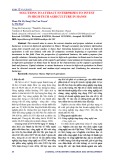



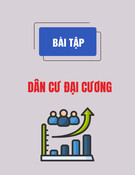
![Sổ tay Hướng dẫn truyền thông về lao động trẻ em [Mới nhất]](https://cdn.tailieu.vn/images/document/thumbnail/2025/20251114/kimphuong1001/135x160/7201763091001.jpg)

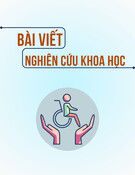





![Cẩm nang Thanh niên hành động [Mới nhất]](https://cdn.tailieu.vn/images/document/thumbnail/2025/20251017/kimphuong1001/135x160/1521760665202.jpg)

